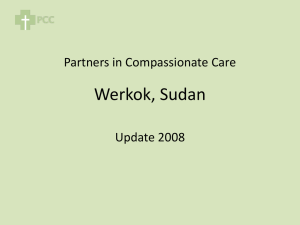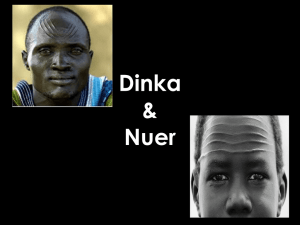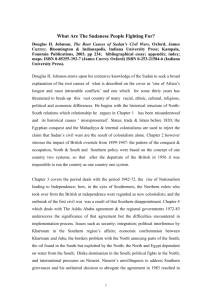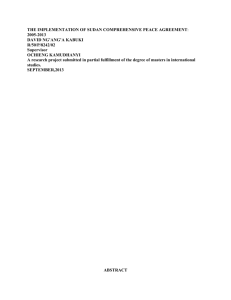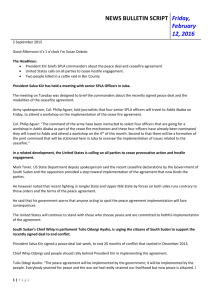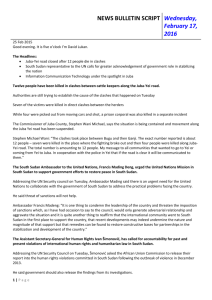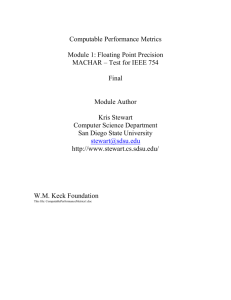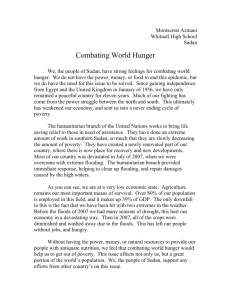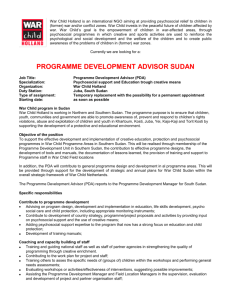The Nuer and Dinka in South Sudan
advertisement
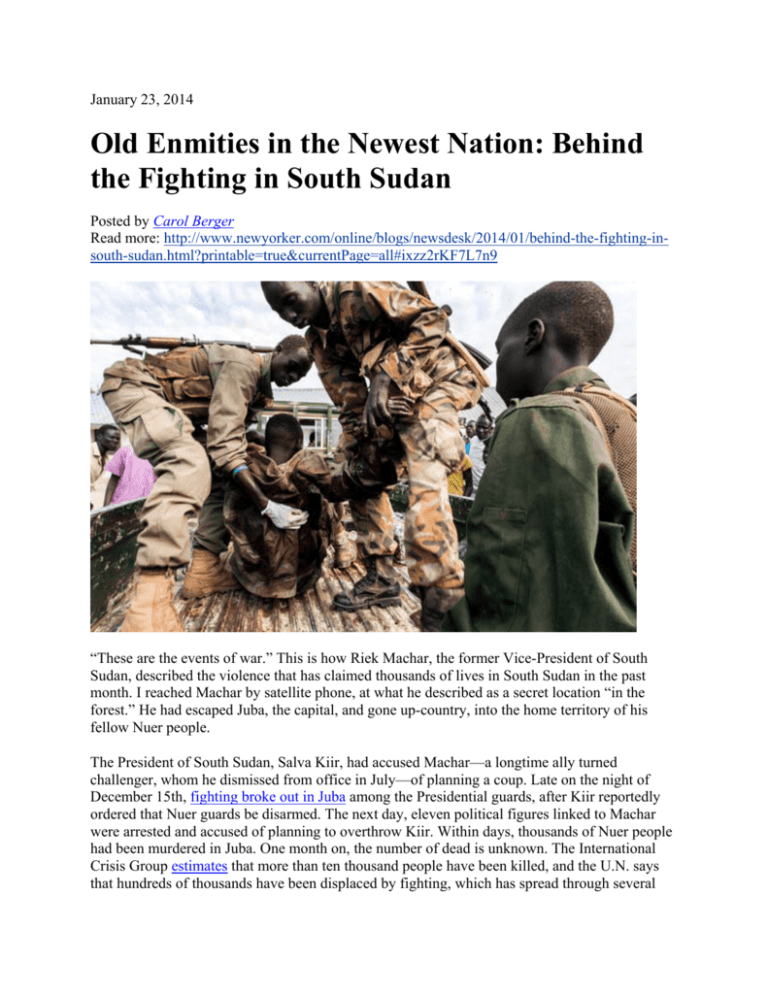
January 23, 2014 Old Enmities in the Newest Nation: Behind the Fighting in South Sudan Posted by Carol Berger Read more: http://www.newyorker.com/online/blogs/newsdesk/2014/01/behind-the-fighting-insouth-sudan.html?printable=true&currentPage=all#ixzz2rKF7L7n9 “These are the events of war.” This is how Riek Machar, the former Vice-President of South Sudan, described the violence that has claimed thousands of lives in South Sudan in the past month. I reached Machar by satellite phone, at what he described as a secret location “in the forest.” He had escaped Juba, the capital, and gone up-country, into the home territory of his fellow Nuer people. The President of South Sudan, Salva Kiir, had accused Machar—a longtime ally turned challenger, whom he dismissed from office in July—of planning a coup. Late on the night of December 15th, fighting broke out in Juba among the Presidential guards, after Kiir reportedly ordered that Nuer guards be disarmed. The next day, eleven political figures linked to Machar were arrested and accused of planning to overthrow Kiir. Within days, thousands of Nuer people had been murdered in Juba. One month on, the number of dead is unknown. The International Crisis Group estimates that more than ten thousand people have been killed, and the U.N. says that hundreds of thousands have been displaced by fighting, which has spread through several states. Eighty thousand South Sudanese have crossed the borders in search of safety in neighboring Uganda, Kenya, Ethiopia, and Sudan. The violence has split the two-year-old nation along ethnic lines, with Machar leading the Nuer, and President Kiir followed, to some extent, by his fellow-Dinka. A U.N. official who visited the country spoke of “horror,” including extrajudicial killings, sexual violence, and massacres committed by both sides. It is hard not to see the events of the past month as a return to the dark days of the civil war between the south and the north in the nineteen-eighties and nineties, in which two and a half million people died from violence, disease, and famine. Given the temperaments of Machar and Kiir, the risk of a drawn-out, brutal conflict is high. Since the twenty-two-year-long civil war ended, in 2005, the story of the conflict has been simplified. Khartoum, the capital of Sudan, later demonized for the atrocities in Darfur, has been held largely responsible for the death toll in South Sudan during the civil war. But, while the Sudanese government did exploit divisions within the south, it should be noted that most of the deaths there were the result of fighting between southerners. The past month has seen a return to those deep divisions along racial lines. But it is not a sudden, or unexpected, turn. For years, tension has been growing over the dominant role of the Dinka, the largest cultural group in South Sudan, which is divided into different clans and subclans spread across a huge territory. (Even among themselves, the Dinka have longstanding disputes.) Land in parts of Juba, as in many other regions of the country, has been claimed by senior military officials, many of whom are Dinka. In a deeply militarized country, those who have the guns have the power. But Machar and his supporters have not spent the past few years sitting idle. The oil in Machar’s home region, Unity State, just south of the border with Sudan, appears to have been of no benefit to the local people. Instead, through a complicated web of companies, the resources have been treated like a personal reward for those who waged the war against Khartoum—a prize for having won independence for South Sudan. On Saturday, news reports said that representatives for Machar and the government, meeting in Addis Ababa, were close to agreement on a cessation of hostilities. But there is little optimism about the government, or Machar’s rebel forces, obeying the terms of any agreement. The talks were slow to start, and the entrance of Uganda on the side of the government has added a regional element to the spreading war. On Thursday, the two sides signed a cease-fire in Addis Ababa. But the agreement is a temporary one, and some issues, particularly the fate of the eleven political figures detained in Juba, will be dealt with separately, in later talks. Machar told me on Sunday that there was no agreement. “The conflict is not yet over,” he said. Until the eleven political figures accused of plotting a coup against Kiir are released from detention in Juba, he said, there will be no end to the fighting. “Without that, there is nothing,” he told me. “It becomes only ink on the paper.” He described the mounting death toll as “very unfortunate.” “They shouldn’t have died,” he said. “That’s why I regret it, but these are the events of war.” At the end of our conversation, he said, “Nobody likes killing. The Ugandans are invading our country. We will give them a lesson.” Machar has shown no hesitation about engaging in a new war, and President Salva Kiir seems to be cut from the same cloth. He assumed power when Colonel John Garang, the leader of the rebel group the Sudan People’s Liberation Army (S.P.L.A.), died in a helicopter crash in 2005, just months after peace had been won. In the years since, Kiir has remained a military man, despite the best efforts of American and European advisers to portray him otherwise. “He’s a sweetheart,” an American adviser to the President told me, without any prompting, one day in Juba. It seemed a curious thing to say about a man who had fought on the front lines of a brutal, two-decade-long civil war. But the description was consistent with the message routinely communicated by Westerners connected to the government of the world’s newest country. There is a tendency to infantilize the military men in charge by talking about them as though they were innocents. Similar rhetoric is used to describe the S.P.L.A.’s former child soldiers, often called the Lost Boys, many of whom now live in the United States, Canada, and Australia. In reality, the brutalized young fighters were trying to escape the war and their S.P.L.A. commanders. One of those senior officers, closely linked to the use of underage combatants, was Kiir. When Machar was a guerrilla commander, he also recruited thousands of child and teen-age fighters. The foreign advisers are in Juba to stage-manage perceptions of one of most violent places on earth. Their work includes everything from hiring the designer who built the set for Oprah Winfrey’s television show and overseeing the construction of the Presidential press center, in Juba, to describing governors who have stolen land from rural communities as engaging in “peace through development.” During the civil war and for the years since it ended, South Sudan has received billions of dollars in aid. But the results of that aid can barely be seen on the ground. Rampant corruption means that millions, if not billions, of dollars have been funnelled out of the country. And yet the United States, in particular, insists that the region is moving forward, as opposed to sinking back into the morass of war-lord-led massacres. Statements in December by U.S. officials and John Prendergast, the co-founder of the Enough Project and a vocal supporter of South Sudan’s independence, linked the current explosion of violence to a 1991 massacre in Bor, where hundreds of Dinka were killed by Nuer fighters under Machar’s command. The implication is that South Sudan needs to take stock of the civil-war killings before it can move forward—that there is a need for something along the lines of South Africa’s Truth and Reconciliation Commission. But this argument ignores the thousands of people who have been killed in the years since the 2005 peace agreement; in many parts of South Sudan, peacetime has been more violent than the final years of the war. The fighting has been along geographic and ethnic lines, with governors and former military commanders building private armies to control their territories. The instigators of this violence have been the very men whom the international community has supported, from governors of far-flung regions to the President himself. At stake is control over resources, including food aid from the international community and funds intended for infrastructure projects. The first time I called Machar, it was late at night on January 8th. I asked what seemed an obvious question: What will you do next? “What do you mean?” he asked sharply. There was a note of impatience, even anger, in his voice. “Well, you’re at war and you’ve gone to the bush, and the talks in Addis are failing.” And then the telephone line went dead. But the next day I got through again. The wind was blowing, and I could hear the engines in the background—vehicles, or perhaps a diesel-powered generator. I asked if he had enough water and food. He said yes to the former and no to the latter. “I can make it,” he said. Machar is sixty-one years old. I asked if he was too old to be at war for a second time. “Here, talk to Angelina,” said Machar, passing the Thuraya to his wife Angelina Teny. In the style of many Nilotic-speaking peoples, Machar had a second wife, a young British woman called Emma McCune. She had been pregnant with their child when she died, in 1993, in a car accident in Nairobi. Machar now has a new second wife, an American woman. I did not ask if she, too, had gone into the bush. Teny, fifty-four, stood by Machar through the war—in the nineties, when he split from the rebel army led by Garang and allied his fighters with the Islamist regime in Khartoum against their fellow-South Sudanese—and into peacetime, when old adversaries, allied once again, proclaimed an independent nation. She is also a politician in her own right, and was once the minister of oil for Unity State. It was impossible to determine where, in the vast territory of South Sudan, Machar and Teny had taken refuge. “We have brought water from ponds,” she told me. “It makes you realize that to live you need very little.” Teny fled Juba, in the early hours of December 16th, in only her slippers and a nightdress. Hours earlier, Kiir’s guards had disarmed her husband’s bodyguards. Kiir said that he had acted to thwart an attempted coup, but his move also seemed like a preëmptive attack by the President against his adversary. What followed were several days of killing. Most of the dead were Nuer. Kiir and most of his senior advisers are Dinka. Kiir, Teny said, “was planning this cleansing. You can have an incident today and the next day have an extermination of an ethnic group.” In Juba, Machar and Teny lived in the same neighborhood as Kiir. But tensions between the two men had been growing for years. Each had built up a private army, drawing on extended kinship networks and recruiting underage soldiers. For months, there were rumors of an impending coup. The military was restive. Soldiers often went months without receiving payment. The violence elsewhere in the country was growing worse. But, for the international community, the focus was somehow always on the threat of a new war with Sudan, rather than on the internal ethnic conflict among Southern Sudanese. In late 2010, the actor George Clooney helped to set up the Satellite Sentinel Project, which uses satellites to monitor the border with Sudan. The repeated message was that the Sudanese were going to move south. But what happened, instead, was that, with help from Darfurian rebels, the South Sudanese moved north, crossing the border to briefly capture some Sudanese oil fields, in April, 2012, less than a year after gaining independence. While the oil fields were being taken, I was staying at a lodge in the town of Wau. Late one day, heavily armed soldiers appeared inside the compound and cordoned off a large area. When I saw that all of the soldiers were Nuer, I knew that Machar had arrived. He was still Vice-President, and the S.P.L.A. had just announced that the oil fields now belonged to the south. There were dozens of soldiers guarding the room where Machar and Teny were to spend the night. One soldier, wearing blue camouflage, was in the darkened room where we talked. He was ironing, with great care, one of Angelina’s blouses. I returned to South Sudan for three months at the beginning of last year, moving between two states, Unity and Lakes. Unity, along the border with Sudan, is home to mostly Nuer people and much of the region’s oil. It is one of the poorest places I have ever seen. Lakes is where people from the Agar Dinka live. For most of the past four years, armed Nuer and Dinka youth in the two states had been carrying out cattle raids and killings. Attacks were made at dawn. Women and children were left for dead after attackers sprayed bullets at their grass huts. People were forced to leave their homes. Some believe that local governors, and soldiers loyal to them, lent active support to the attacks on neighboring peoples. But, in early 2013, things became even worse. The attackers numbered in the hundreds, if not thousands. By the time I left South Sudan, in late March, I had come down with amoebic dysentery, and I said I would never go back. But it wasn’t because of my ill health—it was because the violence had become so terrible. There was constant talk about how Machar was using a helicopter, provided by an international oil company, to fly into remote areas where Nuer fighters were massing. These fighters—whether part of Machar’s private army or Nuer youth acting on their own—were said to be preparing for attacks on neighboring Dinka. Not surprisingly, Dinka people in nearby regions were threatening to move against the Nuer forces. Every few days, there were reports of cattle thefts and killings. The governor of Lakes State, meanwhile, was digging holes in the ground, a practice from the civil war, which were used to imprison young cattle herders as punishment for stealing cattle and for attacking not only Nuer but also other Dinka. While this was going on, I met an Italian filmmaker who had been hired by a U.S. government subcontractor to make a documentary showing people from Nuer and Dinka cattle camps saying that they wanted peace. The images were stunning: young South Sudanese covered in white ash, proudly displaying their longhorned cattle for the camera. The film was supposed to promote peace and quell fears of a war between the Nuer and Dinka. “Where will you go?” I asked Teny when we spoke. The Ugandan and Sudanese governments had declared their support for Kiir. In Bentiu, the capital of Unity State, home to Machar’s Nuer people, soldiers who had joined Machar’s rebellion were in retreat. With government troops advancing to retake the city, the rebel soldiers had burned the market and laid waste to the town. “God will lead us,” she said. “God will guide us.” Carol Berger is a former foreign correspondent and holds a doctorate in anthropology from the University of Oxford. Her master’s and doctoral theses were on the Sudan People’s Liberation Army and its use of underage soldiers. She lives in Cairo, Egypt. Above: A Sudan People’s Liberation Army soldier, who was wounded in renewed fighting, arrives for medical attention at a clinic in Minkamen, Awerial. January 22, 2014. Photograph by Adriane Ohanesian/Reuters.
